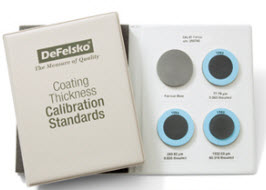1550 Cobb Industrial Dr. | P.O. Box 9098 | Marietta, GA 30065-2098
770-425-1355 (Phone) | 770-425-1354 (Fax) | info@alliedcorrosion.com (Email)
©2018 Allied Corrosion. All rights Reserved.
Made with ❤ by Mighty Good Marketing
Selected:
Certified thickness Standards are used to verify the accuracy and operation of coating thickness gages and are an important component in fulfilling both ISO/QS-9000 and in-house quality control Coating Thickness Standards requirements. Contracts often specify that coating thickness measurements be taken by gages whose measurement accuracy is traceable to a National Metrology Institute such as NIST or PTB.
Standards are typically purchased as an accessory to DeFelsko coating thickness gages. Many customers find it more practical to verify the accuracy of their own gages in-house, rather than utilize DeFelsko’s calibration services. This is particularly true when many gages are in use and/or when accuracy verification is performed often.
There are 5 types of coating thickness standards available:
Certified thickness Standards are used to verify the accuracy and operation of coating thickness gages and are an important component in fulfilling both ISO/QS-9000 and in-house quality control requirements. They are typically purchased as an accessory to DeFelsko coating thickness gages. Many customer’s questions are answered in the FAQ page.
![]()
Certified thickness Standards are used to verify the accuracy and operation of coating thickness gages and are an important component in fulfilling both ISO/QS-9000 and in-house quality control requirements. Contracts often specify that coating thickness measurements be taken by gages whose measurement accuracy is traceable to a National Metrology Institute such as NIST or PTB.
Standards are typically purchased as an accessory to DeFelsko coating thickness gages. Many customers find it more practical to verify the accuracy of their own gages in-house, rather than utilize DeFelsko’s calibration services. This is particularly true when many gages are in use and/or when accuracy verification is performed often.
There are 5 types of coating thickness Standards available from DeFelsko:
Certified Coated Metal Plates are the best solution for verifying the calibration, accuracy and operation of most magnetic, eddy current or ultrasonic coating thickness gages including magnetic pull-off gages as well as many competitive models. They fulfill both ISO and in-house quality control requirements. At ± 0.43 Certified Coated Metal Plates are our most accurate solution. A durable epoxy coating over 1018 steel or 6061-T6 aluminum and protective binder ensures long life.
Certified Polystyrene Blocks are for use with gages that measure over 1500 μm (60 mils) with an accuracy of ± (2.5 μm + 0.05% of thickness) [± (0.1 mil + 0.05% of thickness)].
Certified Plastic Shims (foils) provide an economical alternative with a reduced accuracy of ± 2 μm (± 0.08 mil). A coating thickness gage measures shim thickness when placed over a smooth metal surface (zero plate). Alternatively, they can be placed over the customer’s uncoated substrate. They are not suitable for use with magnetic pull-off gages.
Non-Certified Plastic Shims (foils) provide a quick operational check of the instrument and they allow the user to perform practice measurements when placed over metal. A set is included with every electronic DeFelsko coating thickness gage. They are not suitable for use with magnetic pull-off gages.
Zero Plates are uncoated steel or aluminum disks. A zero plate is included with most coated metal sets. The first gage measurement is on a zero plate to verify that the gage measures zero correctly. Electronic gages can usually be adjusted to “0” if necessary. A zero plate is also a convenient base onto which a plastic shim or polystyrene block can be placed for measurement.
Standards should be replaced when they become visibly worn or scratched.
Your electronic PosiTector® and PosiTest® gages come with NON-CERTIFIED PLASTIC SHIMS for use as a quick reference out in the field or on the floor. But these non-certified plastic shims are not ideal for verifying gage accuracy for the following reasons:
We include non-certified shims with our electronic gages to provide a quick verification of gage operation and allow the user to perform practice measurements when placed over metal.
Yes, our Standards may also be used with many competitive gages provided they operate on magnetic, eddy current, or ultrasonic principles.
There are no shelf life concerns with Coating Thickness Standards. Humidity and temperature have negligible effect on the accuracy of the Standards. The only factor affecting the life of Standards is visible wear resulting from excessive use or improper handling. We recommend customers begin their calibration intervals on the date of receipt.
DeFelsko Corporation does not provide expiry dates on the Calibration Certificates for our Standards. Customer dependent factors have shown to be too critical in establishing calibration intervals. These factors are primarily the thickness of the Standard, frequency of use, care taken during use, handling and storage of the Standard.
With all these factors taken into consideration, DeFelsko recommends that our customers establish their own calibration intervals based upon their own experience with Standards.
Certified Standards are used to verify the accuracy and operation of a coating thickness gage. Select the Standard that most closely matches the measuring range of your gage. See our Ordering Chart for assistance.
In most instances, it will be more economical to trade-in Standards for a new set.
Shims, sometimes referred to as foils, are small, colored plastic strips of varying thicknesses between ≅25 μm (1 mil) and ≅1.5 mm (60 mils). They measure 3 x 8 cm (1 x 3 inches). Shims are commonly used to simulate a coating.
For electronic magnetic and eddy-current gages, they are placed onto an uncoated piece of ferrous or non-ferrous metal, and then measured with the gage. Shims may be used individually or stacked to create additional thicknesses.
Ultrasonic coating thickness gages can only measure one shim thickness at a time. The shim must be placed over a flat, rigid object such as a glass pane. The substrate material does not have to be the same material as the material being tested.
Although they are made of the same material and cut to the same dimensions, there is a difference in accuracy, packaging and purpose. Neither is suitable for use with magnetic pull-off gages.
Certified Plastic Shims (foils) provide an economical alternative to coated metal plate Standards with a reduced accuracy of ± 2 μm (± 0.08 mil). Gage performance can be conveniently verified in the field or in the lab on a regular basis as called for by some international test methods. Shims are placed over a smooth metal surface (zero plate) and a measurement taken. These strips of flat polyester can be used to adjust (optimize) a coating thickness gage in the intended range of use directly over the customer’s uncoated substrate.
Certified Plastic Shims are sold individually or as a complete set of eight. Each Certified Shim is individually serialized and labeled with its measured thickness (mils and microns) obtained with measurement equipment traceable to NIST. They are packaged in their own plastic protective pouch. One Certificate of Calibration showing traceability to NIST is included with each shim or set of shims. Their labeled thicknesses are accurate to within ± 2 μm (± 0.08 mils). They are for use with electronic magnetic, eddy-current and ultrasonic coating thickness gages.
Non-Certified Plastic Shims (foils) are used to provide a quick verification of gage operation when placed over metal and they allow the user to perform practice measurements.
Non-Certified Shims are sold as a set of five packaged in one cardboard envelope. Their labeled thicknesses have accuracies ranging from ± 5 to 20%. One set is included with each DeFelsko electronic coating thickness gage. They are for use with electronic magnetic, eddy-current and ultrasonic coating thickness gages.
When adjusting to a shim thickness, resultant gage measurements are less accurate and must be recalculated by taking into account the tolerances of both the instrument and the shims. When shims are used it is necessary to be aware of the possibility of additional measurement errors. Factors experienced with plastic shims that are not usually present with coated metal plate Standards include (but are not limited to):
Shims, which are permissible for adjusting electronic gages with constant pressure probes should not be used for adjusting mechanical pull-off gages including the PosiTest® FM and PosiPen®. Shims can act as a leaf spring and cause the probe of a magnetic pull-off gage to be “pushed” off the surface prematurely, resulting in an erroneous reading.
Yes, but the cost effective alternative is to trade them in on the purchase of new ones when they become visibly scratched or worn. Trade-in reduces the price of new Certified Plastic Shims. Additionally, one or more shims can be purchased separately to complete a set.
Coated metal standards require little maintenance. If plates become dirty, the epoxy surface can be gently cleaned with a cotton swab dipped in isopropyl alcohol. Do not clean the exposed metal surfaces with alcohol as this will remove any protective films. To prevent rusting, the steel standards come complete with corrosion inhibitor paper and may require periodic application of a light machine oil or 3-in-1 oil to the exposed metal surfaces. Do not apply oil to the epoxy or labeled surfaces. The aluminum plates should not require any maintenance to the exposed metal surfaces. When not in use, all coating thickness Standards should be stored in a cool, dry place.
Exposure of the epoxy covered steel to magnetic fields may cause the plates to become slightly magnetic. Magnetism in steel plates can affect readings taken with gages using magnetic principles. Do not store epoxy coated steel plates near magnetic sources. If your plates get exposed to a magnetic source they can be restored by using a degausser.
The polystyrene thickness standards are recommended for use with several models of ultrasonic gages. Ultrasonic gages emit a high frequency pulse of sound that travels through the material and reflects back when it encounters a different density material. The thickness of the material is calculated based on the time for the reflection (or echo) to be received and the speed of the sound in the material. Most ultrasonic gages are preset with a ultrasonic velocity that is representative of most coatings. Improved accuracy can be achieved by adjusting the gage’s ultrasonic velocity to exactly match the material being measured. Some gage models allow you to directly input the material’s velocity if it is known. Other models calculate the material’s ultrasonic velocity by measuring a known thickness of a representative material. DeFelsko provides the ultrasonic velocity to allow the calibration standards to be used with either method.
Each national body has an organization(s) responsible for coordinating the national measurement system that provides traceability of measurement results to reference standards that are internationally recognized. The body in the US responsible for this is National Institute of Standards and Technology (NIST). If equipment is calibrated in another country the calibration of that equipment will reference the respective nation’s responsible organization. Physikalisch-Technische Bundesanstalt (PTB) is Germany’s equivalent of NIST.

1550 Cobb Industrial Dr. | P.O. Box 9098 | Marietta, GA 30065-2098
770-425-1355 (Phone) | 770-425-1354 (Fax) | info@alliedcorrosion.com (Email)
Made with ❤ by Mighty Good Marketing
We care about your privacy! In order to run a successful website, we are setting cookies and accessing and storing information on your device for various purposes. By continuing to browse this site, you are agreeing to our use of cookies.
If you wish to disable cookies, please visit our Privacy Policy for more information.
Got It! Thanks!Privacy policy